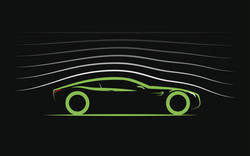Efficient optimisation of aerodynamic design
Integrating computational fluid dynamics optimisation with computer-aided design (CAD) would enable one to easily manipulate an optimised shape and further analyse it. The CAD program could even be used to control subsequent manufacture. EU-funded scientists working on the ABOUTFLOW(opens in new window) (Adjoint-based optimisation of industrial and unsteady flows) project plan to develop interfaces to do just that. Gradient-based optimisation exploits a function's gradient at a given point to determine in which (mathematical) direction to search for best solutions. Adjoint methods for computing the gradient have become the approach of choice for aerodynamic shape design. Such adjoint-based optimisation techniques outperform other methods due to their relatively low computational cost. ABOUTFLOW scientists are integrating currently available shape and topology design approaches with the gradient-based optimisation approach to eliminate the need for manual interpretation of optimised designs by an expert user. Instead, the optimal design will feed directly into a CAD program for subsequent analyses. In addition, and equally importantly, the team is improving the efficiency of adjoint calculation in cases of small levels of flow instability or unsteady flows, as often occur over surfaces of turbo-machinery, cars and wind turbines. Conventional methods of dealing with the instability involve storage and recalculation of the flow solution at previous time increments, significantly increasing memory and runtime. At mid-term, numerous advances in the robustness, accuracy and efficiency of adjoint calculation have been achieved. Newly developed adjoint code has been implemented on a graphical processor unit demonstrating important performance gains. Unsteady adjoint calculation capabilities have also been significantly improved and integrated into industrial adjoint solvers. They have been successfully exploited to find aerodynamic solutions for turbo-machinery and automobiles, the latter verified against wind tunnel test data. Finally, researchers are laying the foundations for integration of the adjoint gradients into design chains. Improved accuracy of topology optimisation and development of various mesh and meshless representation paradigms are among the accomplishments to date. In the coming months, the algorithms will be tested on realistic industrial problems to assess the best approaches. The most promising will then be incorporated into the design chains of the industrial partners for final evaluation.







